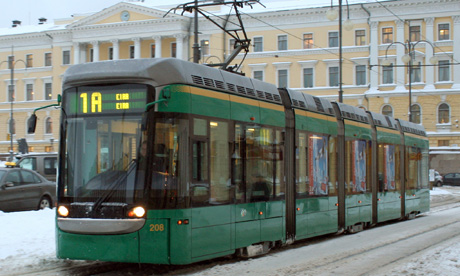In other words a few inches of snow doesn’t stop @ grade LRT/street level Tramways; a foot and so long as the snow sweaping is effective the LRV/Trams keep on operating.
Croydon Tramlink
TransLink’s bus company is expensive, inefficient and dysfunctional in inclement weather; US & European Tramways operate without a doubt in snow conditions.
Spotlight on trams: Helsinki

Helsinki is a city of 480,000 people with a surrounding metropolitan area of around 1.3 million people. It is very similar in size to Edinburgh (478,000) and it also the capital of its country with a population slightly less than that of Scotland at 5.3 million.
It is a remarkable and beautiful city with big plans for the future which include a fast rail link to St Petersburg, promoting and developing its airport as a European hub to China and investigating a 50 mile tunnel link to Tallinn in Estonia. This is a city in which seventy percent of the land area and almost all development land is owned by the City Council. This is a city with big plans and the ability to implement them.
The city also has ambitious plans for its own expansion, particularly on to waterfront areas previously occupied by docklands and inner harbours which have moved out to a new complex at Vuosaaric on the eastern edge of the conurbation. It is expected that an additional 100,000 people will be accommodated in these new developments. A key factor in planning these new development areas is integrated public transport by Metro in part but mainly by tram.
Helsinki’s tram network is one of the oldest electrified tram networks in the world. It forms part of the city public transport system organised by Helsinki Regional Transport Authority and operated by Helsinki City Transport. The trams are the main means of transport within the city centre and 56.6 million trips were made back in 2004, which is more than those made with the Helsinki Metro.
The first tram network was established in 1890 and electrification took place in 1900. In common with many other European cities, the tram system was under threat from buses in the mid 20th century and the city decided to close the system in the early 1960s. However this decision was reversed during the early 1970s and by 1976 the network was being expanded again. Today the tram is a key part of the city’s infrastructure.
The city has a current total of twelve lines with a further six lines planned over the next few years. As well as owning almost 70% of the land area of the city, the Helsinki authorities also own the public transport system and critically, the energy company that supplies power for the tram network. This degree of ownership of the core elements of the system means that it is relatively easy to extend the network and guarantee connections to new housing areas without having to haggle with different land owners, developers, public utility owners and contractors.
Another aspect of infrastructure provision in Helsinki is the way in which it seems to happen efficiently and painlessly. Not for them the contractual disputes, delays in implementation or flaws in construction which are leapt upon by a triumphant public and trumpeted in the media elsewhere.
Perhaps it is in the dour uncomplaining Finnish character to just let other people get on with things in the knowledge that they will eventually be successful. Or perhaps they are just used to doing infrastructure provision really well.























